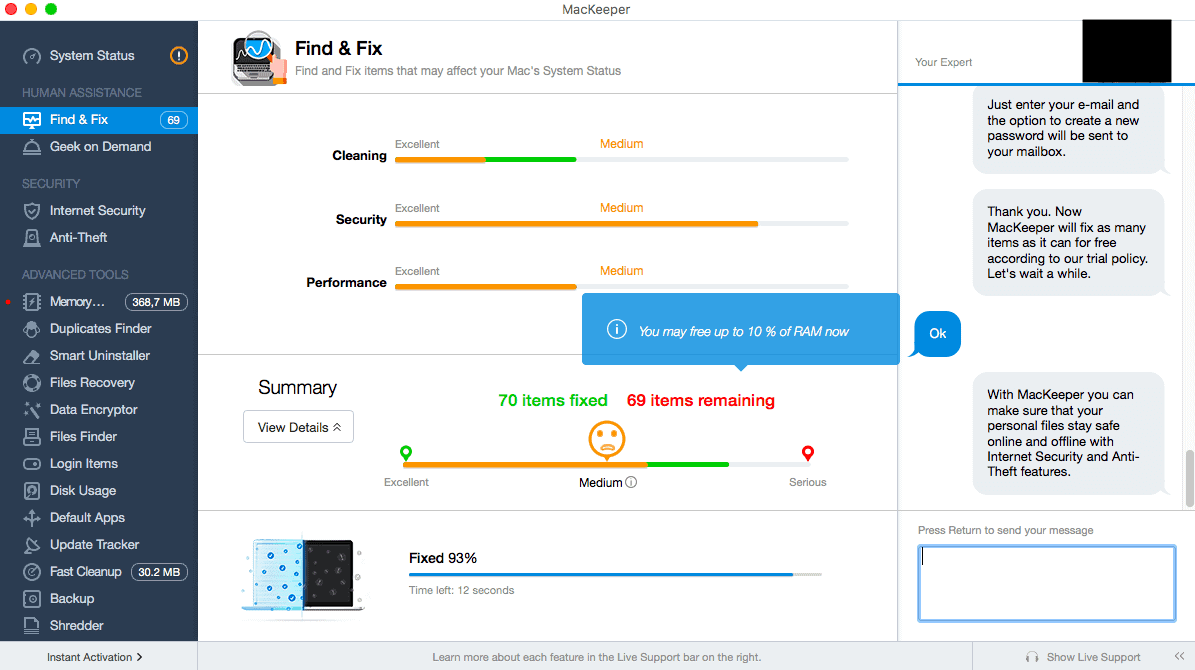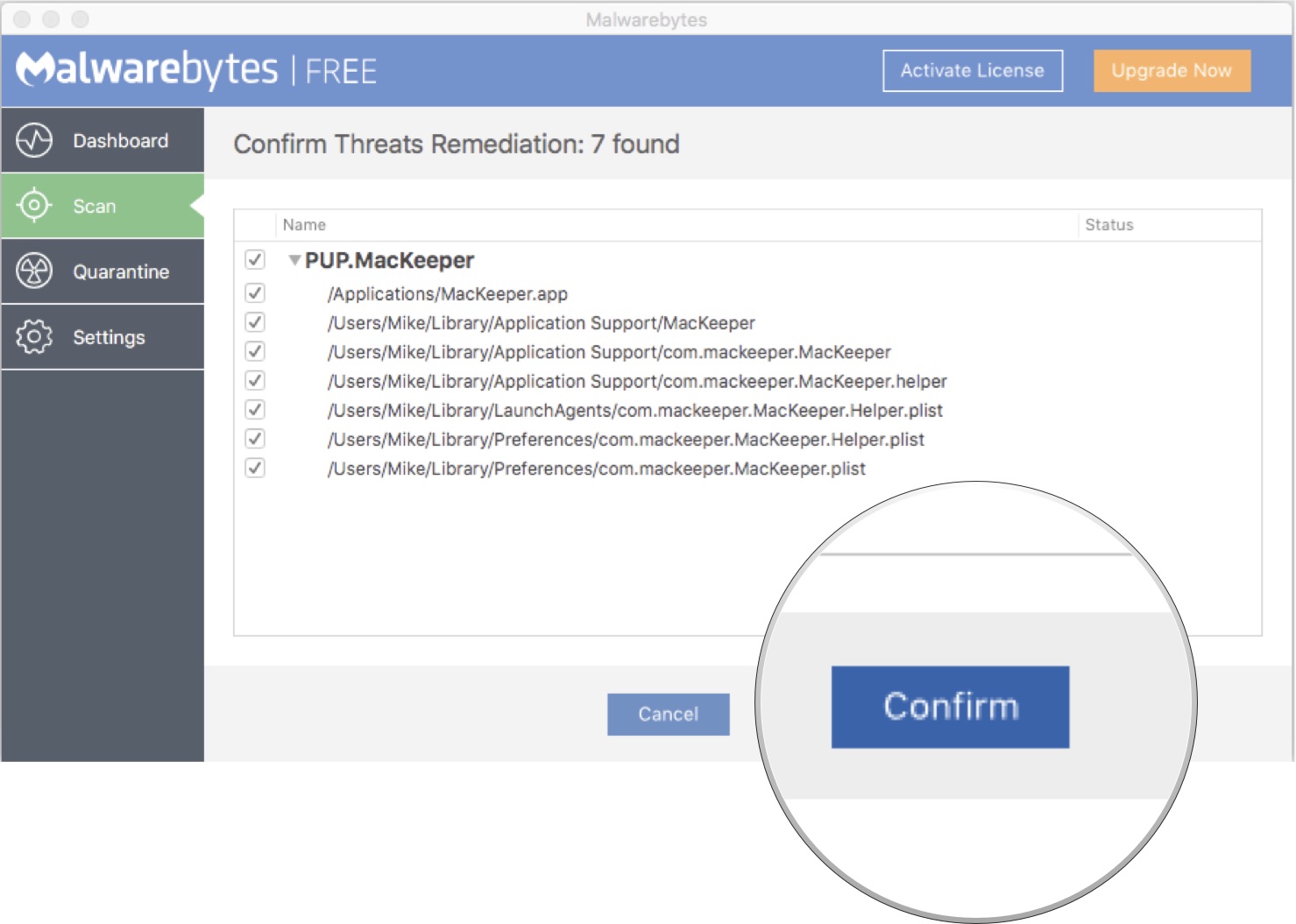MacKeeper is a Mac cleaning application by Kromtech Alliance. According to the developer, the app has 1.4 million Mac clients using it. Without going into a long discussion about MacKeeper’s trustworthiness and business ethics, we’ll have an honest look at MacKeeper’s features. This application is full-packed with various Mac optimization tools.
The interface
Right after installing MacKeeper, you’ll see its trademark robot figure. This aims to show an automated approach to Mac cleanup; at the same time, MacKeeper lets you talk to a real human via Skype support, the link to which you’ll find in the top right corner. The whole right panel looks like a giant chat window. This space MacKeeper uses to sell you extra features and other add-ons.
The interface is pretty clean (for a cleaning application) with all the utilities placed in the sidebar to the left. The icons were easy to grasp as well as the names of the features themselves. On a different note, you’ll notice the abundance of pop-ups and dialogue boxes that constantly cry for your attention.
Mackeeper Tool Chest
MacKeeper also detected 13 adware threats — mainly other Mac cleaning tools it deemed potentially unwanted. Bear in mind that MacKeeper is a paid application and in order to remove any items you’ll have to pass through a pay wall.
- How to use Find & Fix tool in MacKeeper The Find & Fix feature scans all MacKeeper tools at once so you can fix all items in a click. Find & Fix is divided into Cleaning, Performance, Privacy, and Security categories — identical to the MacKeeper sidebar. Each category uses a specific group of MacKeeper features to scan and fix items on a Mac.
- Genuine MacKeeper new privacy security and Mac performance tool activation code ¥ 698.00 ¥ 99.00 Price MacKeeper provides your Mac with the ability to safely clean up, find duplicates, smart uninstall, anti-virus, adware cleaner, Track My Mac, security cleaner, Login item, update tracking and more with 12 items.
Before you get to clean anything, you got two main routes to choose from: either follow an automated cleanup script or start cleaning things manually. The latter option is good for experienced Mac users. The automated route is called Find & Fix mode.
How To Login To Mackeeper
What are the main MacKeeper features?
As we said earlier, MacKeeper features are so many that it is wrong to keep calling it a “Mac cleaner.” For example, it has a VPN tool, a tracking service, an ad blocker, etc. This makes it a swiss-army knife type of program for universal Mac maintenance. But before you get lost in the many options, here are some most prominent ones:
Junk cleanup
Duplicates finder
Memory cleaner
Update tracker
Login item manager
Internet security
Device tracker
Password protection
VPN service
Ad blocker utility
Find & Fix: A guided cleanup
MacKeeper suggests to automatically scan your Mac for issues with a feature it calls Find & Fix. This option is conveniently placed at the top, above other elements. The scanning algorithm in Find & Fix goes through 4 consecutive steps:
- Cleaning
- Performance
- Privacy cleanup
- Security or antivirus
Just as I tried to run my first scan, I was asked to give MacKeeper Full Disk Access in Preferences. This resulted in a few extra clicks, and I couldn’t go further without restarting the app — a rather cumbersome experience.
The scanning process took about 10 minutes on my 250 GB MacBook Pro 2019. The app found 3.3 GB of junk files I could delete. Interestingly, MacKeeper’s alternative, CleanMyMac X found 5.3 GB.
MacKeeper also detected 13 adware threats — mainly other Mac cleaning tools it deemed potentially unwanted.
Bear in mind that MacKeeper is a paid application and in order to remove any items you’ll have to pass through a pay wall. Still, there were a couple of free tools that I was able to use in the trial version. One of those is Memory Cleaner, which belongs to the next group of utilities called Performance.
MacKeeper review: Performance tools
MacKeeper sports a RAM cleaner tool that shows occupied memory in real time. By pressing “Clean memory” you flush the occupied memory slots, releasing some fresh memory. This, in theory, should unfreeze some memory-demanding program that has hung up.
What else is taking its toll on Mac’s memory? Applications, of course. In the same group of utilities, MacKeeper has a tab called Apps & Processes. Surprisingly enough, the program doesn’t differentiate between these two. Anyway, users can force quit processes that demand too much memory. You can filter this very long list of processes by their memory appetites and also by their system status.
To minimize possible harm, MacKeeper will not close important system processes. Every single item from my System Processes was locked from intervention, which raises a question of why display them here in the first place. Here, the app seems to be following “you can look, but do not touch” principle.


Within the same group of tools you’ll notice the Update Tracker, which I found to be a bit out of place here, since it doesn’t directly affect Mac performance. With this tool you can update many apps at once, given you bought the paid plan.
Security features

MacKeeper takes Mac security seriously, which becomes obvious if you look at the sheer number of its security features. Here you have an Antivirus, an adware cleaner, and ad blocker. You can even check your email account for potential data leakage. For example, according to MacKeeper, my email has been leaked 19 times. Wow, that’s impressive! Immediately after I submitted by email for check, I received a foggy email about “Protecting my password” with MacKeeper. At that point I decided to stop experimenting with that feature.
According to the developer’s site, MacKeeper is able to detect spyware and viruses. Unfortunately, I couldn’t neither confirm nor deny this, as MacKeeper found 0 viruses on my Mac. According to Wikipedia, MacKeeper’s antivirus relies on Avira’s anti-malware database, which adds some weight to its security tool pack.
Is MacKeeper safe?
In the past, MacKeeper was known to be associated with infamous “Your Mac is infected” messages. Though the company distanced itself from such tactics, MacKeeper’s safe status remains controversial. For example, Malwarebytes considers MacKeeper a “potentially unwanted program” or PUP. On the other hand, according to MacKeeper’s website, it has its own anti-malware lab that studies “new and unknown threats affecting Mac.”
If you’re in doubt as to whether MacKeeper is safe to use on your Mac, you may consider some of its best-known alternatives.
Mackeeper Removal Tool
The best-known MacKeeper alternatives
CleanMyMac X by MacPaw is another Mac cleaning solution and one of the oldest cleanup tools on the market. CleanMyMac X is an app that is notarized by Apple. Notarization is a process that confirms that an app is free from malicious files.
Here is a detailed MacKeeper review that compares its features with CleanMyMac X.
CleanMyMac X has a couple of Mac cleaning tools that MacKeeper lacks. For example, there is a space visualization tool, Space Lens, that builds an interactive map of your storage.
You can download free demo of CleanMyMac X here, from the developer’s site.
That was our take on MacKeeper — one of the most talked-about apps in the Mac world. In this MacKeeper review we’ve covered its features and also touched the question of whether MacKeeper is safe. Though we’ve been fiddling around with a free trial, you may get a paid version to get the real gist of it. Its yearly plan costs 95.40 euro. Or you may consider alternative cleaning solutions for your Mac.
